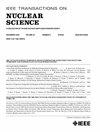A 1-D CNN Algorithm for Low-Background β Detection With Time Projection Chamber
IF 1.9
3区 工程技术
Q3 ENGINEERING, ELECTRICAL & ELECTRONIC
引用次数: 0
Abstract
Low-background低背景 $/beta $ 检测对环境安全至关重要。本文介绍了一种基于一维卷积神经网络(1-D CNN)的算法,用于使用时间投影室(TPCs)进行低背景$\mathrm {beta }$ 检测,目的是对探测器捕获并使用电子系统记录的$\mathrm {beta }$ 和背景信号进行分类。实验结果表明,所提出的算法在处理复杂背景和 $\mathrm {\beta }$ 信号方面非常有效。神经网络在两个不同条件的数据集上进行了训练和测试。在每个数据集中,测试结果显示背景剔除率超过 98%,$\mathrm {\beta }$ 保留率约为 55%。与传统的铅屏蔽检测方法相比,该算法的应用实现了无铅、低背景 $\beta $ 检测。这可以大大减小仪器的体积和重量,从而极大地拓展其潜在应用领域。
本文章由计算机程序翻译,如有差异,请以英文原文为准。
求助全文
约1分钟内获得全文
求助全文
来源期刊

IEEE Transactions on Nuclear Science
工程技术-工程:电子与电气
CiteScore
3.70
自引率
27.80%
发文量
314
审稿时长
6.2 months
期刊介绍:
The IEEE Transactions on Nuclear Science is a publication of the IEEE Nuclear and Plasma Sciences Society. It is viewed as the primary source of technical information in many of the areas it covers. As judged by JCR impact factor, TNS consistently ranks in the top five journals in the category of Nuclear Science & Technology. It has one of the higher immediacy indices, indicating that the information it publishes is viewed as timely, and has a relatively long citation half-life, indicating that the published information also is viewed as valuable for a number of years.
The IEEE Transactions on Nuclear Science is published bimonthly. Its scope includes all aspects of the theory and application of nuclear science and engineering. It focuses on instrumentation for the detection and measurement of ionizing radiation; particle accelerators and their controls; nuclear medicine and its application; effects of radiation on materials, components, and systems; reactor instrumentation and controls; and measurement of radiation in space.
 求助内容:
求助内容: 应助结果提醒方式:
应助结果提醒方式:


